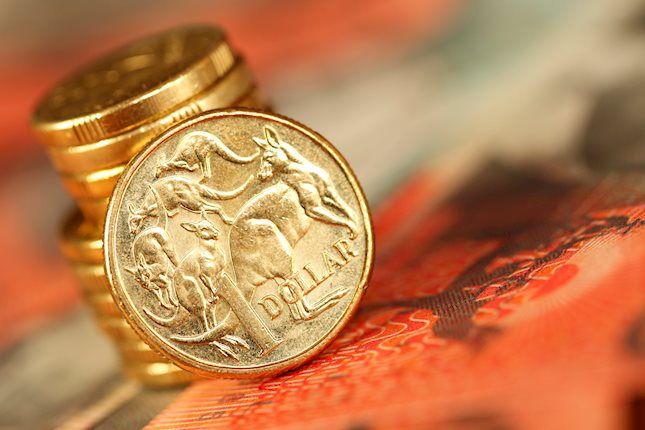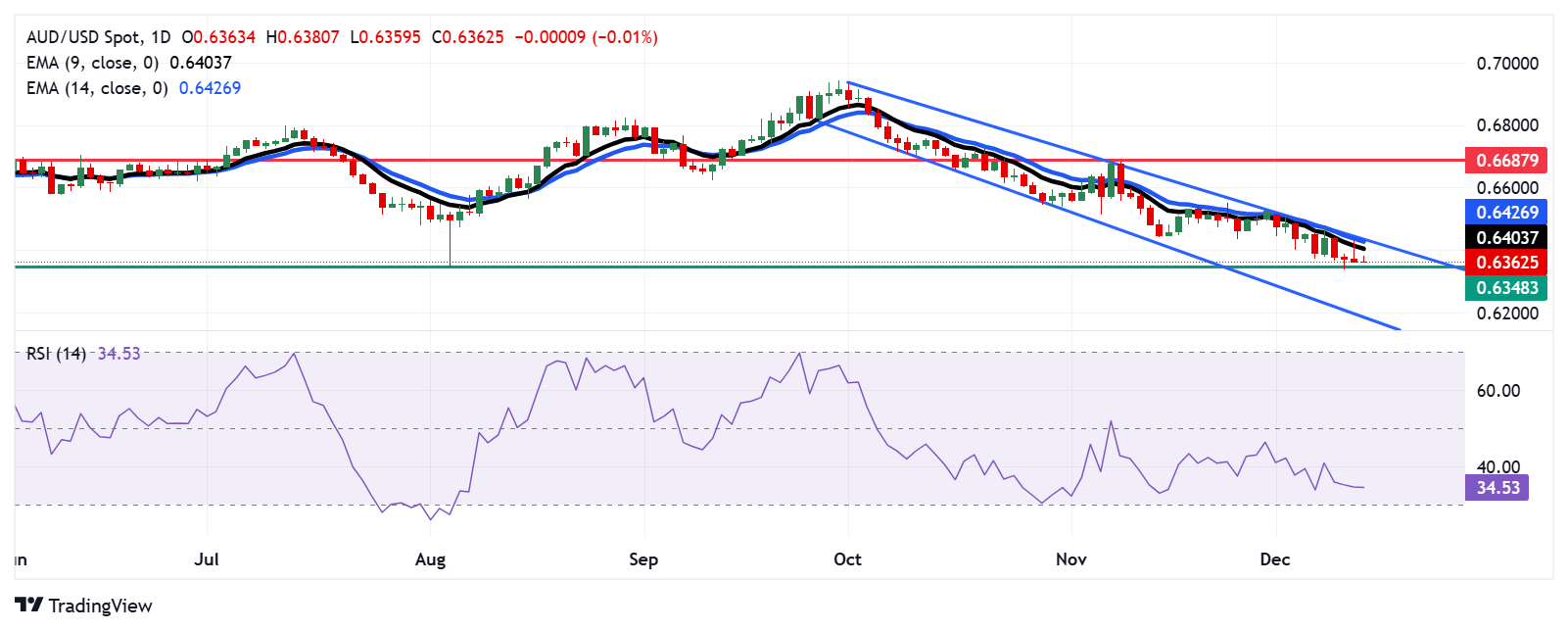- The Australian Dollar holds losses as Trump’s tariff threats have created a headwind for the risk-sensitive currencies.
- The AUD struggles as Beijing begins retaliation against Trump trade sanctions, launching a probe into US-based Nvidia.
- The US Dollar gained ground following a hotter-than-expected US PPI report released on Thursday.
The Australian Dollar (AUD) continues to struggle against the US Dollar (USD) on Friday. The tariff threats from Trump’s administration have boosted the US Dollar (USD) across the board and created a headwind for the AUD/USD pair. Additionally, speculations about a potential 10% tariff on Chinese goods might drag the AUD lower as China has been the largest trading partner of Australia.
The AUD received support after the release of domestic mixed employment data on Thursday. The seasonally adjusted Employment Change rose by 35,600, bringing the total number of employed people to 14,535,500 in November. Meanwhile, the Unemployment Rate dropped to 3.9%, the lowest since March, lower than market estimates of 4.2%.
The US Dollar appreciated due to the hotter-than-expected US Producer Price Index (PPI) report released on Thursday. The US PPI jumped 0.4% MoM in November, the largest gain since June, after an upwardly revised 0.3% increase in October. This reading was better than the 0.2% expected.
The US Federal Reserve (Fed) interest rate decision will take center stage next week. Traders are now fully pricing in a 25 basis point rate cut on December 18, according to the CME FedWatch Tool.
Australian Dollar faces challenges due to tariff threats from Trump’s administration
- Beijing has already begun retaliation against Trump trade sanctions, launching a probe into Nvidia, threatening to blacklist a US apparel company, blocking the export of critical minerals to the United States, and tightening the supply chain for drones.
- US Consumer Price Index (CPI) rose to 2.7% year-over-year in November from 2.6% in October. The headline CPI reported a 0.3% reading MoM, in line with the market consensus. Meanwhile, the core CPI, excluding volatile food and energy prices, climbed 3.3% YoY, while the core CPI increased 0.3% MoM in November, as expected.
- The Australian Dollar received downward pressure on Wednesday as China, a key trading partner of Australia, saw its top leaders and policymakers consider letting the Chinese Yuan fall in response to an expected sharp hike in US tariffs, per Reuters.
- China President Xi Jinping stated on Tuesday, "China has full confidence in achieving this year's economic target." Xi emphasized that China will continue to serve as the largest engine of global economic growth and asserted that there would be no winners in tariff wars, trade wars, or tech wars.
- China's Trade Balance (CNY) increased to CNY 692.8 billion in November, up from CNY 679.1 billion in the previous month. Exports grew by 1.5% year-over-year in November, compared to the 11.2% rise in October. Meanwhile, imports increased by 1.2% YoY, recovering from the 3.7% decline recorded earlier.
- The RBA kept the Official Cash Rate (OCR) unchanged at 4.35% in its final policy meeting in December. RBA Governor Michele Bullock highlighted that while upside inflation risks have eased, they persist and require ongoing vigilance. The RBA will closely monitor all economic data, including employment figures, to guide future policy decisions.
- Australia's economy grew at its slowest annual pace since the pandemic in the third quarter. The OZ nation’s Gross Domestic Product (GDP) rose 0.3% in the September quarter, missing market forecasts of 0.4%. Weaker-than-expected GDP growth made markets almost fully price in a rate cut next April at 96% (from 73% before), according to Refinitive interest rate probabilities data.
Technical Analysis: Australian Dollar maintains its position above 0.6350, yearly lows
The AUD/USD pair hovers near 0.6360 on Friday. The daily chart analysis suggests a strengthening bearish bias as the pair moves downwards within a descending channel pattern. The 14-day Relative Strength Index (RSI) also remains slightly above the 30 level, indicating sustained bearish momentum.
The yearly low of 0.6348, last seen on August 5, serves as immediate support. A successful break below this level could strengthen the bearish bias and lead the AUD/USD pair toward the descending channel’s lower boundary around the 0.6190 level.
On the upside, the AUD/USD pair may find initial resistance around the nine-day Exponential Moving Average (EMA) at 0.6404. The next barrier appears at the 14-day EMA at 0.6427, which is aligned with the upper boundary of the descending channel. A decisive breakout above this channel could drive the pair toward the seven-week high of 0.6687.
AUD/USD: Daily Chart
Australian Dollar PRICE Today
The table below shows the percentage change of Australian Dollar (AUD) against listed major currencies today. Australian Dollar was the weakest against the US Dollar.
| USD | EUR | GBP | JPY | CAD | AUD | NZD | CHF | |
|---|---|---|---|---|---|---|---|---|
| USD | 0.06% | 0.06% | 0.21% | 0.09% | 0.05% | 0.04% | 0.06% | |
| EUR | -0.06% | 0.00% | 0.16% | 0.02% | -0.01% | -0.01% | 0.00% | |
| GBP | -0.06% | 0.00% | 0.17% | 0.01% | -0.01% | -0.01% | 0.00% | |
| JPY | -0.21% | -0.16% | -0.17% | -0.13% | -0.18% | -0.19% | -0.17% | |
| CAD | -0.09% | -0.02% | -0.01% | 0.13% | -0.05% | -0.04% | -0.03% | |
| AUD | -0.05% | 0.00% | 0.00% | 0.18% | 0.05% | -0.01% | 0.01% | |
| NZD | -0.04% | 0.01% | 0.01% | 0.19% | 0.04% | 0.00% | 0.02% | |
| CHF | -0.06% | -0.01% | -0.00% | 0.17% | 0.03% | -0.01% | -0.02% |
The heat map shows percentage changes of major currencies against each other. The base currency is picked from the left column, while the quote currency is picked from the top row. For example, if you pick the Australian Dollar from the left column and move along the horizontal line to the US Dollar, the percentage change displayed in the box will represent AUD (base)/USD (quote).
Information on these pages contains forward-looking statements that involve risks and uncertainties. Markets and instruments profiled on this page are for informational purposes only and should not in any way come across as a recommendation to buy or sell in these assets. You should do your own thorough research before making any investment decisions. FXStreet does not in any way guarantee that this information is free from mistakes, errors, or material misstatements. It also does not guarantee that this information is of a timely nature. Investing in Open Markets involves a great deal of risk, including the loss of all or a portion of your investment, as well as emotional distress. All risks, losses and costs associated with investing, including total loss of principal, are your responsibility. The views and opinions expressed in this article are those of the authors and do not necessarily reflect the official policy or position of FXStreet nor its advertisers. The author will not be held responsible for information that is found at the end of links posted on this page.
If not otherwise explicitly mentioned in the body of the article, at the time of writing, the author has no position in any stock mentioned in this article and no business relationship with any company mentioned. The author has not received compensation for writing this article, other than from FXStreet.
FXStreet and the author do not provide personalized recommendations. The author makes no representations as to the accuracy, completeness, or suitability of this information. FXStreet and the author will not be liable for any errors, omissions or any losses, injuries or damages arising from this information and its display or use. Errors and omissions excepted.
The author and FXStreet are not registered investment advisors and nothing in this article is intended to be investment advice.
Recommended content
Editors’ Picks

AUD/USD languishes near YTD trough near 0.6350
AUD/USD stays vulnerable near 0.6350, sitting at multi-month lows early Friday. A bullish US Dollar and higher on hawkish December Fed rate cut bets weigh on the pair amid a risk-off market mood. Dovish RBA tilt also remains a drag on the major.

USD/JPY retakes 153.00 on fading hopes of BoJ rate hike
USD/JPY buyers are re-attempting 153.00 in Asian trading on Friday. The pair's upside is due to the growing acceptance that the BoJ will not raise rates next week. Further, the ongoing US Dollar advance, bolstered by expectations for a hawkish Fed rate cut, supports the pair.

Gold buyers not ready to give up yet
Gold's price looks to resume this week’s recovery to monthly highs of $2,726 early Friday, following Wednesday’s brief aberration. The US Dollar consolidates recent gains alongside the US Treasury bond yields amid a relatively light economic calendar heading into the weekend.

Pro-crypto French Hill selected as Chairman of the House Financial Services Committee
Republican party members selected pro-crypto French Hill as the Chairman of the US House Financial Services Committee on Thursday to replace retiring Patrick McHenry.

Can markets keep conquering record highs?
Equity markets are charging to new record highs, with the S&P 500 up 28% year-to-date and the NASDAQ Composite crossing the key 20,000 mark, up 34% this year. The rally is underpinned by a potent mix of drivers.

Best Forex Brokers with Low Spreads
VERIFIED Low spreads are crucial for reducing trading costs. Explore top Forex brokers offering competitive spreads and high leverage. Compare options for EUR/USD, GBP/USD, USD/JPY, and Gold.
